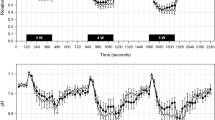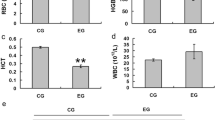Abstract
Iron-deficiency anemia leads directly to both reduced hemoglobin levels and work performance in humans and experimental animals. In an attempt to observe a direct link between work performance and insufficient iron at the cellular level, we produced severe iron deficiency in female weanling Sprague-Dawley rats following five weeks on a low-iron diet. Deficient rats were compared with normal animals to observe major changes in hematological parameters, body weight, and growth of certain organs and tissues. The overall growth of iron-deficient animals was approximately 50% of normal. The ratio of organ weight: body weight increased in heart, liver, spleen, kidney, brain, and soleus muscle in response to iron deficiency. Further, mitochondria from heart and red muscle retained their iron more effectively under the stress of iron deficiency than mitochondria from liver and spleen.
Metabolism of iron in normal and depleted tissue was measured using tracer amounts of59Fe administered orally. As expected, there was greater uptake of tracer iron by iron-deficient animals. The major organ of iron accumulation was the spleen, but significant amounts of isotope were also localized in heart and brain. In all muscle tissue examined the59Fe preferentially entered the mitochondria. Enhanced mitochondrial uptake of iron prior to any detectable change in the hemoglobin level in experimental animals may be indicative of nonhemoglobin related biochemical changes and/or decrements in work capacity.
Similar content being viewed by others
References
Y. Ohira, V. R. Edgerton, G. W. Gardner, B. Senewiratne, R. J. Barnard, and D. R. Simpson,Brit. J. Haematol. 41, 365 (1979).
V. R. Edgerton, S. L. Bryant, C. A. Gillespie, and G. W. Gardner,J. Nutr. 102, 381 (1972).
Y. Ohira, V. R. Edgerton, G. W. Gardner, B. Senewiratne, and D. R. Simpson,Nutr. Rep. Int. 18, 647 (1978).
P. Ericsson,Acta Med. Scand. 188, 361 (1970).
Y. Ohira, PhD Dissertation, University of Southern California (1980).
R. P. Cusack and W. D. Brown,J. Nutr. 86, 383 (1965).
P. R. Dallman and H. C. Schwartz,Pediatrics 35, 677 (1965).
P. R. Dallman and H. C. Schwartz,J. Clin. Invest. 44, 1631 (1965).
C. A. Finch, L. R. Miller, A. R. Inamdar, R. Person, K. Seiler, and B. Mackler,J. Clin. Invest. 58, 447 (1976).
P. R. Dallman,J. Nutr. 97, 475 (1969).
C. A. Finch, P. D. Gollnick, M. P. Hlastala, L. R. Miller, E. Dillmann, and B. Mackler,J. Clin. Invest. 64, 129 (1979).
B. J. Koziol, Y. Ohira, D. R. Simpson, and V. R. Edgerton,J. Nutr. 108, 1306 (1978).
I. Gutmann and A. W. Wahlefeld,Methods of Enzymatic Analysis,3, 1464 (1978).
D. Carmichael, J. Christopher, J. Hegenauer, and P. Saltman,Am. J. Clin. Nutr. 28, 487 (1975).
J. B. Chappell and S. V. Perry,Nature 173, 1094 (1954).
T. O. Kleine and W. D. Steinman,Res. Exp. Med. 172, 19 (1978).
L. A. Sordahl, D. Johnson, Z. R. Blailock, and A. Schwartz,Methods Pharmacol. 1, 247 (1971).
E. H. Hartree,Anal. Biochem. 48, 422 (1972).
S. Marklund,Clin. Chim. Acta 92, 229 (1979).
P. R. Dallman, inIron in Biochemistry and Medicine, A. Jacobs and M. Worwood, ed, Academic Press, New York, p. 437.
J. R. Goodman, J. B. Warshaw, and P. R. Dallman,Pediat. Res. 4, 244 (1970).
A. Hunter,Quart. J. Med. New Ser. 15, 107 (1946).
H. Rothenbacher and A. R. Sherman,J. Nutr. 110, 1648 (1980).
J. Hegenauer, L. Ripley, and P. Saltman, inProteins of Iron Metabolism, E. B. Brown, P. Aisen, J. Fielding, and R. R. Crichton, eds., Grune and Stratton, 1977, New York, p. 403.
S. Pollack, R. M. Kaufman, and W. H. Crosby,Science 144, 1015 (1964).
Author information
Authors and Affiliations
Rights and permissions
About this article
Cite this article
Ohira, Y., Hegenauer, J., Saltman, P. et al. Distribution and metabolism of iron in muscles of iron-deficient rats. Biol Trace Elem Res 4, 45–56 (1982). https://doi.org/10.1007/BF02789133
Received:
Accepted:
Issue Date:
DOI: https://doi.org/10.1007/BF02789133
Index Entries
- Iron, distribution and metabolism in rat muscle
- metabolism, of Fe in rat muscle
- rat muscle, Fe distribution and metabolism in
- iron deficiency, in rat muscle, Fe distribution and metabolism in
- anemia, effect on hemoglobin levels and work performance
- hemoglobin, effect of Fe deficiency on
- work performance, effect of Fe deficiency on




